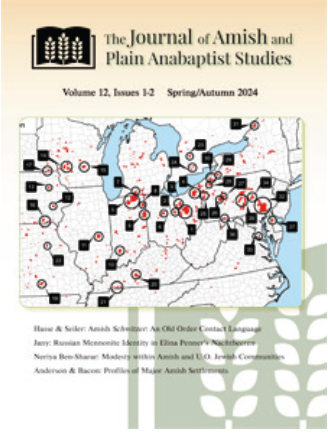

The current issue of the Journal of Amish and Plain Anabaptist Studies (12:1–2) features an interesting section on Amish settlements in North America, profiling 38 of the largest and best-known communities. An Amish settlement refers to a self-designated area of residences, congregations, businesses, and other institutions that can host multiple Amish and plain Mennonite affiliations, allowing members to share resources even as they engage in schism-related disagreements. In many of the settlements, conferences and meetings between local Amish leaders may have a similar importance to that of national and regional meetings. In the same way, dating and marriage as well as cooperation between businesses take place within these settlements. The profiles are also interesting because they describe the community identity of these settlements, noting whether they are strict, more relaxed, progressive, or conservative, although there has been an increase in mobility among Amish and plain Mennonites that creates mixed areas. The editors of this section, Cory Anderson and Rachel Bacon, also include population figures and projections up until 2050. They note that while growth is “generally expected among the Amish, given large family size and high retention rates,…the rate of growth is uncertain. Some evidence suggests there is a gradual decline in birth rates and some settlements experience higher rates of out-migration than others.” This issue is available at: https://ideaexchange.uakron.edu/amishstudies/

The annual review of trends in world Christianity, published in the International Bulletin of Mission Research (January), this year focuses on regional trends. Demographers Gina Zurlo, Todd Johnson, and Peter Crossing look at the major trends in the demography of Christianity over the last 125 years, as well as offering projections up to the year 2050. They find that Africa’s overtaking Latin America as the continent with the most Christians in 2018 continues, with 49 percent of the population identifying as Christian (compared to 41.6 percent for Islam). Practitioners of African Traditional Religion dropped from 58 percent in 1900 to about 8 percent in 2025. The researchers add, however, that the current “presence of ethnic religionists is a somewhat unexpected development, as many in the early 20th century predicted the complete disappearance of these traditional religions within a generation.” In Asia, the fastest current Christian growth rates are in South Asia and Southeastern Asia. Mongolia, Nepal, and Cambodia have shown significant growth since 1990, representing some of the newest expressions of Christianity in the world.
The Middle East continues its sharp decline in Christians, now down to 4.1 percent of the region’s population. This is especially the case in a country like Syria, which has faced civil war and migration, but also in Lebanon (where the Christian population has dropped an “astounding” 43 percent). The six Middle Eastern countries that have seen significant Christian growth—Qatar, Kuwait, United Arab Emirates, Bahrain, Saudi Arabia, and Oman—have mainly drawn immigrants, such as Catholic Filipinos. In Europe, the major trends continue to be de-Christianization, the shift in the racial and ethnic identities of the remaining Christians through migration, and the growth of Islam (with 53 million Muslims now in the region). Latin America sees stability in its Christian numbers (dropping only from about 95 percent in 1900 to about 92 percent in 2025), but the region has seen more religious pluralism, including Muslims (numbering 1.9 million in 2025). The main change continues to be the growth of Protestantism, the Church of Jesus Christ of Latter-day Saints, and Jehovah’s Witnesses. Oceania probably shows the most dramatic growth of Christianity (outside declines in Australia), with Papua New Guinea moving from majority traditional religions to majority Christian (95 percent). For more information on this article, visit: https://journals.sagepub.com/home/ibm